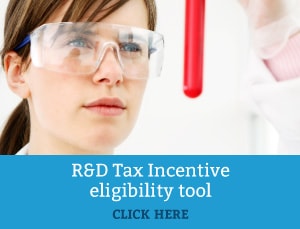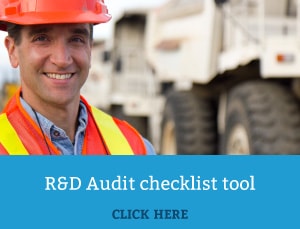Aviation
December 18th, 2014
This case study shows the application of key legislative requirements for qualifying R&D activities as they apply to relevant activities in the aviation industry.
Business Scenario
Airtime Helicopters (Airtime) was established in 2008 to provide charter, scenic and photography services.
Airtime felt a need to further enhance the recording quality and stability of its current camera unit to improve clarity and visibility during vertical, monochromatic imaging, mapping and surveying. In 2009, Airtime began an R&D project dedicated to developing and designing a camera which would provide helicopter camera crews with unprecedented levels of equipment reliability for use in mapping and imaging applications.
Airtime engaged in a program of systematic, investigative and experimental activities to overcome the significant technical uncertainty and develop new knowledge regarding the impact of specific variables on the effectiveness of the new attachment design.
After experimentation, Airtime needed to determine the eligibility of its proposed R&D activities in order to know if it qualified for the R&D Tax Incentive. Once it identified the specific activities that qualified as R&D, Airtime needed to assess whether each activity was a core or supporting R&D activity. After self-assessing, Airtime decided to register one core activity and two supporting activities with AusIndustry.
Airtime’s Core R&D Activity
Design and development of a series of prototypes to achieve the technical objectives and prove the hypothesis (design and development of a camera for mapping and surveying purposes).Airtime conducted the design and development of spring settings on specific camera types, as well as design consideration on the impact of different wind conditions.
Airtime believed its camera solution could be achieved by conducting the following activities to reduce the unit’s vibration:
- A series of information was gathered and evaluated to identify knowledge gaps and achieve the technical objectives.
- A series of design experiments were undertaken to prove the hypothesis.
- A series of trial data was analysed and evaluated to achieve satisfactory reproducible results.
- A series of developments and modifications were undertaken to interpret the algorithm data and draw conclusions that served as a starting point for the new design hypothesis.
Commentary
Identifying Core R&D Activities There are two types of core R&D activities:- Experimental activities whose outcome can not be determined in advance on the basis of current knowledge, information or experience, but can only be known by exercising a systematic progression of work that follows the principles of established science, proceeding from hypothesis to experiment, observation and evaluation, and lead to logical conclusions.
- Experimental activities that are conducted for the purpose of creating new knowledge.
Hypothesis Defined AusIndustry recognises a hypothesis as a statement or proposition about what result is expected if certain conditions are put in place and certain actions are carried out in an experiment. It can range from an assumption or proposition to a theory, but it must establish the experimental activity and form part of a broader systematic progression of work undertaken by the company. It must be evident that the claimed experiment has been designed to test the hypothesis.
If the outcome of an activity can be obtained without a hypothesis, then the activity will not be considered R&D.
Airtime’s Supporting R&D Activities
Background research to evaluate current knowledge gaps and determine feasibility (background research for mapping and surveying camera unit).The following background research was conducted by Airtime:
- Literature search and review
- Consultation with industry professionals and potential clients to determine the level of interest and commercial feasibility of such a project
- Preliminary equipment and resources review with respect to capacity, performance and suitability for the project
Airtime’s background research qualified as R&D because it assisted in identifying the key elements of the project, thereby directly supporting the core activity.
Ongoing analysis of customer or user feedback to improve the prototype design (feedback R&D of the camera and its mapping and surveying abilities). Airtime conducted several tests to improve the efficiency of the project and commercial analysis and functionality review.The analysation process was necessary to evaluate the performance capabilities of the newly developed design in the field and to improve any imperfections, therefore qualifying the experiments as supporting R&D activities.
Commentary
Identifying Supporting R&D Activities Activities that do not form part of the core experimental activities may still be eligible as supporting R&D activities. Supporting R&D activities are directly related to an eligible core R&D activity. They must have been performed for the primary purpose of supporting a qualified R&D activity.What records and specific documentation did Airtime keep?
To meet the R&D Tax Incentive requirements, Airtime had to save documents that outlined what it did in its core R&D activity, including experimental activities and documents to prove that the activities took place in a systematic manner.
Airtime only kept records of its literature search findings, leaving vast room for improvement in the area of substantiation.
As a company claiming R&D, you always want to be ‘compliance ready’ — meaning if you were audited by the ATO, you could present documentation to show the progression of your R&D activity. Here are some types of documentation that would be beneficial to save in the case of an audit:
- Project records/ lab notes
- Photographs/ videos of various stages of build/ assembly/ testing
- Prototypes
- Testing protocols
- Results or records of analysis from testing/ trial runs
- Tax invoices
- Conceptual sketches
- Email correspondence
- Patent application number
- Progress reports and meeting notes
Click here for the PDF version of this case study.
Categories
- ATO Guidance and Materials
- AusIndustry Guidance and Materials
- Case Law
- Federal Budget 2021
- Federal Budget 2022
- Federal Budget 2024
- For Accountants
- General Information
- Government Policy and Treasury
- Industry Specific Issues
- Interpretative Decisions
- Legislation and Parliamentary Matters
- R&D Tax Credit
- R&D Tax Funding Strategies
- R&D Tax Loans
- Recent News
- Tax Determinations
Archives
- July 2024
- June 2024
- May 2024
- April 2024
- March 2024
- February 2024
- January 2024
- December 2023
- November 2023
- October 2023
- September 2023
- August 2023
- July 2023
- June 2023
- May 2023
- April 2023
- March 2023
- February 2023
- January 2023
- December 2022
- November 2022
- October 2022
- September 2022
- August 2022
- July 2022
- June 2022
- May 2022
- April 2022
- March 2022
- February 2022
- January 2022
- December 2021
- November 2021
- October 2021
- September 2021
- August 2021
- July 2021
- June 2021
- May 2021
- April 2021
- March 2021
- February 2021
- January 2021
- December 2020
- November 2020
- October 2020
- September 2020
- August 2020
- July 2020
- June 2020
- May 2020
- April 2020
- March 2020
- February 2020
- January 2020
- December 2019
- November 2019
- October 2019
- September 2019
- August 2019
- July 2019
- June 2019
- May 2019
- April 2019
- March 2019
- February 2019
- January 2019
- December 2018
- November 2018
- September 2018
- July 2018
- June 2018
- May 2018
- April 2018
- March 2018
- February 2018
- January 2018
- December 2017
- November 2017
- September 2017
- August 2017
- July 2017
- June 2017
- May 2017
- April 2017
- March 2017
- February 2017
- January 2017
- December 2016
- November 2016
- October 2016
- September 2016
- August 2016
- July 2016
- June 2016
- May 2016
- April 2016
- March 2016
- February 2016
- January 2016
- December 2015
- November 2015
- October 2015
- September 2015
- August 2015
- July 2015
- June 2015
- May 2015
- April 2015
- March 2015
- February 2015
- January 2015
- November 2014
- October 2014
- September 2014
- August 2014
- July 2014
- June 2014
- May 2014
- April 2014
- March 2014
- February 2014
- January 2014
- December 2013
- November 2013
- October 2013
- September 2013
- May 2013
- April 2013
- March 2013
- September 2012
- August 2012
- June 2012


 Free Call: 1800 792 676
Free Call: 1800 792 676





 News & Research
News & Research



